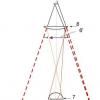In 2019, the unique electronic warfare systems "Palantin", "Divnomorye" and "Tirada-2S" will enter service with the Russian troops.
Overview of the new electronic warfare systems "Palantin", "Rtut-BM", "Divnomorie" and "Tirada-2S": distortion of navigation fields by the slight movement of impulses
For the first time, these promising models of electronic warfare equipment were announced at the end of 2017 by Yuri Borisov, then Deputy Minister of Defense, and now Deputy Prime Minister of the Russian government. He said that the new ground-based electronic warfare systems “significantly surpass existing domestic and foreign counterparts in terms of the range and number of simultaneously reconnoitered and suppressed radios. electronic means the enemy, the suppression range, are distinguished by the possibility of using targeted (selective) interference and maximum automation of control.
As reported in open sources of information, today the Palantin, Divnomorye and Tirada-2S electronic warfare systems are already being mass-produced and supplied to the troops.
On the battlefield "throw" "Stole"
The fundamentally new electronic warfare complex of the operational-tactical level "Palantin" surpasses the electronic warfare systems of previous generations in its capabilities. The capabilities of its high-tech equipment make it possible to "dazzle" the enemy in the shortwave and ultrashortwave ranges, as well as deprive him of cellular and trunking communications. Palantin is capable of providing radio reconnaissance and suppression of all known enemy radio communication systems, including radio equipment based on a modern software-defined platform (SDR).

For existing and prospective enemy radio communication systems, Palantin creates targeted discrete-barrage, band-barrier and barrage frequency interference. The complex is highly mobile, it includes only a few cars.
What is also very important is that this complex is endowed with a system-forming function: it is able to unite single network operation of various electronic warfare systems. With its help, at all levels of control, the current situation is monitored online and the issues of synchronized, coordinated use of electronic warfare equipment at different base points are resolved.
As the Department of Information and Mass Communications of the Ministry of Defense of Russia recently reported, on the basis of the Interspecific Center for the Training and Combat Use of Electronic Warfare in Tambov, military personnel are being retrained - for the latest Palantin electronic warfare complex. 98 military personnel of the 24th separate electronic warfare battalion of the Western Military District have already taken part in the planned exercises, where, in the course of rearmament, old models were replaced with the latest developments of special electronic warfare equipment equipped with the Palantin complex.
The press service of the Central Military District, in turn, reported that in 2019, the modern Palantin electronic warfare systems, according to the state defense order, will go into service with the troops of the Central Military District. It is noted that the re-equipment of military units and subunits of electronic warfare will significantly increase the combat capabilities of the grouping of electronic warfare troops of the district and will allow them to perform larger and more complex tasks.

Under the dome"
Servicemen of the electronic warfare unit of the motorized rifle formation of the Central Military District, stationed in the Kemerovo Region, hid the command post under an impenetrable "dome". It was possible to protect the command post from the impact of shells with electronic fuses and guided missiles of a mock enemy with the help of the latest EW 1L262 "Mercury-BM" complex. It is designed to protect manpower and equipment, cover the areas of concentration of troops, individual stationary and mobile objects, is capable of neutralizing projectiles equipped with radio fuses on an area of up to 50 hectares.
Complex "Mercury-BM" creates a "dome" over the protected area. When projectiles enter the protected area, they self-destruct at a safe distance or deactivate.
Complex "Divnomorye": I came, I saw, I conquered
Capable of "umbrella" of the most powerful interference "close" from radar detection objects on a site of several hundred kilometers, the latest Russian electronic warfare complex "Divnomorye" - a breakthrough development of domestic scientists and designers. This electronic warfare complex is designed to cover command posts, groupings of troops, air defense systems, important industrial and military-political centers from detection by enemy radars.

Electronic warfare complex "Divnomorie"
The performance characteristics of the novelty are classified. Open sources of information about Divnomorye are extremely sparing, but this data is enough to understand that the complex is unique in its class.
Its combat work is fully automated. "Smart" equipment, having detected a target, independently analyzes the signal. Its type, direction and radiation power are determined literally instantly. High-tech automation determines the plan and chooses the most effective type suppression. Powerful interference radiation completely neutralizes any type of enemy radar.
"Divnomorye" is a real all-rounder. For him, there are no impossible tasks, with the same guaranteed success, he "jamming" any reconnaissance equipment.
The new Russian complex “hammers” with interference both ground systems, and radars installed on E-3 AWACS, E-2 Hawkeye and E-8 JSTAR aircraft, and equipment for helicopters and unmanned aerial vehicles. When using "Divnomorya" they "go blind" and satellite systems radar.
The complex unfolds in just a few minutes. This mobility makes him virtually invulnerable. A combat vehicle (only one, but there were several in the complexes of the previous generation) advances to a designated position, performs a task, and quickly leaves from under a possible enemy strike. In fact, he came, he saw, he conquered.

A number of military experts suggest that Divnomorye can replace three electronic warfare systems in the Russian troops at once - Moskva-1, Krasukha-2 and Krasukha-4.
Navigation "fields" "sown" with interference
Military personnel of the electronic warfare units of the Central Military District during special exercises near Yekaterinburg “threatened” the targeting of high-precision weapons of a potential enemy on the covered troops. The calculations of mobile electronic warfare systems deployed more than 10 mobile posts and carried out a distortion of the navigation "fields" created by the systems for determining the location of the "enemy" strike systems. For this, EW specialists used modern Krasukha and Murmansk systems, which have the capability of radio suppression with powerful radiation at a distance of several hundred kilometers.
"Tirada-2S": spacecraft killer
The contract with the Ministry of Defense of the Russian Federation for the supply of this unique complex was publicly signed at the Army-2018 forum. The REPS complex (electronic jamming of communications) "Tirada-2S" directly from the Earth's surface is capable of interrupting satellite communications with the complete incapacitation of the spacecraft.

This heavy-duty complex "works" with a narrow beam aimed at certain frequencies of satellite communication channels. Of course, when creating any spacecraft great attention given to its noise immunity. But "Tirada-2S" puts such targeted barrage interference on enemy satellites that completely block the ability to transmit a signal to the addressee, and the energy of the device in space is catastrophically quickly spent on attempts to overcome the electromagnetic curtain "delivered" by the Russian ground-based EW station.
By the way, the Tirada-2S complex is not a modernization of equipment of previous generations and not a deep processing of equipment from Soviet times. Latest system electronic jamming of communications was created by domestic scientists and designers in the 2000s.
Drones didn't fly
Specialists of the electronic warfare troops during a recent special exercise at the Totsk training ground in the Orenburg region, using the Borisoglebsk-2 complex, “prevented” an attack by attack unmanned aerial vehicles on the command post of the covered unit.
During the practical actions, the servicemen conducted radio reconnaissance and found signals for controlling unmanned aerial vehicles. aircraft within a radius of 30 kilometers. According to them, the coordinates of the drones that were moving in the direction of the guarded military facility were determined. Using automated jamming stations of the Borisoglebsk-2 complex, the servicemen suppressed the control signals of reconnaissance and strike UAVs of a mock enemy and completely disabled them.

Automated jamming station of the Borisoglebsk-2 complex
Russian EW troops - development is on the rise
Former head of the EW Department of the US Army Lori Bakhut assessed the situation in the field of electronic warfare: “Our most serious problem is that we have not fought in the conditions of suppression of communications for several decades, so we do not know how to fight like that. Not only do we lack tactics, techniques of actions and the order of their implementation, but even the preparation for conducting hostilities in the absence of communications ... The United States does not have such extensive electronic warfare capabilities as Russia does. We have very good radio intelligence, and we can listen to everything and everything, but we do not have even one-tenth of their ability to disable equipment.
Critical to the successful conduct of hostilities, today the electronic warfare system armed forces Russia is a set of coordinated measures and actions of the troops, which are carried out in order to reduce the effectiveness of command and control of troops and the use of weapons by the enemy, to ensure the specified effectiveness of command and control of troops and the use of their weapons of destruction. The achievement of these goals is carried out within the framework of defeating enemy command and control systems, communications and reconnaissance by changing the quality of information circulating in them, the speed of information processes, parameters and characteristics of electronic means.
Also, the domestic electronic warfare system provides reliable protection of its control, communications and intelligence systems from damage, as well as protected information about weapons, military equipment, military facilities and military operations from technical means intelligence of foreign countries.
Successful testing and adoption of new types of electronic warfare qualitatively increases the level of comprehensive protection of our units and subunits on the battlefield.
In recent years in Russian troops EW received more than 600 new generation systems. 19 newest types of special electronic warfare equipment have been created for the troops. This significantly expanded the range of potential enemy electronic equipment to be destroyed and increased the range of radio suppression by 3.5 times.
The share of modern complexes in the EW troops has reached 67%. It is planned that by 2021 the level of their equipment new technology will be 70%.
The SPR-2 station is designed to protect manpower and equipment from the fire of mass-used artillery ammunition equipped with radio fuses by interfering with them in order to prematurely detonate them at a safe height or block them (transfer to strike action) and is used to cover the first echelon, command points, starting positions of launchers, areas of concentration of troops and military equipment in the areas of crossings, as well as covering mobile objects (source).

Electronic warfare machine 1L262 "Mercury-BM" (Russia)

Jamming is provided:

- timely detection of radiation from radio fuses and the creation of interference to it in a time of no more than 1.5-2 s;

- determination of the carrier frequency of radio fuses and the formation of a response interference to it with an error of no more than 200-300 Hz;
- the excess of the interference level above the threshold level during the time of signal accumulation in the integrating device of the radio fuse.
One of the main components of the station is a search receiver, which at first roughly and then accurately determines the carrier frequency of the radio fuse, followed by its reproduction while maintaining the phase characteristics of the received signal. In this case, the frequency measurement time does not exceed several tens of microseconds, and its reproduction time can reach several ms, which makes it possible to form a quasi-continuous interference. To increase the probability of suppression, the response interference is modulated by the Doppler frequency.
It provides suppression of autodyne single-frequency radio fuses, including fuses with special anti-jamming channels. The station equipment works automatically, including in motion.
Functional:
- automatic prohibition of interference emission by interfering signals in their respective frequency channels for a set time interval;
- reconnaissance mode (without interference emission);
— information about the frequency channels through which signals are received;
Chassis:
1L29 / SPR-2 SPR-2M
BTR-70 and BTR-80 MT-LBu
TTX stations:
1L29 / SPR-2 1L262 / SPR-2M
Crew 4 people 2 people
Power supply from the built-in unit or from the mains vehicle from the built-in unit or from the electrical network of the vehicle
The angle of rotation of the antenna device + -150 degrees + -150 degrees
Operating frequency range 95-420 MHz 95-420 MHz
Interference coverage area 20-60 ha 20-50 ha
Equivalent sensitivity 100-110 dB/W 95-110 dB/W
Electronic countermeasure potential not less than 300 W 250 W
Probability of suppression not less than 0.8 not less than 0.8
Number of suppressed VHF radio communication lines - 3-6
Continuous operation time at least 6 hours at least 6 hours
Station deployment time no more than 4 minutes up to 10 minutes
Operating conditions from -40 to +50 degrees C from -40 to +50 degrees C
Modifications:
- 1L29 / SPR-2 "Mercury-B" - the first model of the SPR-2 station on the BTR-70 chassis. Adopted by the USSR Armed Forces until 1991.
- 1L262 / SPR-2M "Rtut-BM" - a modernized version of the station, made on a new element base. The station is capable of, in addition to radio fuses, suppressing VHF radio communications. Tests completed in 2012. First deliveries to the Russian Armed Forces - 2013.
Station 1L29 / SPR-2 "Mercury-B"
Station 1L262 / SPR-2M "Rtut-BM" / RB-321B
EW station / radio fuse interference station (SPR). Developed in the 1980s by VNII Gradient, chief designer- V.G. Lopatin. Mass production started by the Bryansk Electromechanical Plant until 1991
On May 25, 2011, the State Contract No. 249/7/S/11-12 for the supply of 5 1L262 stations in the amount of 718.4 million rubles was concluded between the Ministry of Defense of Russia and VNII Gradient. Deliveries of products were expected in two batches - until 10/25/2011 and until 09/25/2012 (). Since 2011, the stations have been assembled by the Kazan Optical and Mechanical Plant (KOMZ). On June 27, 2011, a contract was signed between KOMZ and OJSC Muromteplovoz for the supply of 11 MT-LBus with modifications for the installation of station equipment 1L262 (). The manufacturer of equipment for stations 1L29 and 1L262 is NPO Kvant (Veliky Novgorod). At the beginning of 2013, the contract for the supply of 5 stations was not fulfilled, the chassis were not accepted by military acceptance and were returned to the manufacturer by a court decision ().
The second contract for the supply of 1L262 stations was concluded between the Russian Ministry of Defense and KRET on April 23, 2012 under No. 227 / ZA / 2012 / DRGZ (according to other sources - 249 / 7 / C / 12-6). further, between KRET and KOMZ on 06/113/2012, a contract was signed for the manufacture, adjustment and tuning of blocks and assemblies of 1L262 products in the amount of 734.2 million rubles. The deadline for delivery is October 2013 (). Apparently, we are talking about 6 stations here (in total, 5 + 6 = 11 units).
The third contract was concluded on February 7, 2014 between the Ministry of Defense and KRET under No. 14-4-51 / 46 / ZA for the supply of jamming stations 1L262 (RB-321B) in the amount of 21 units. On February 12, 2014, a co-executive agreement was signed with NPO Kvant for the manufacture and supply of products. The cost of work on it is estimated at 1.395 million rubles, that is, 66.4 million rubles per item. Until October 2015, 7 stations should be commissioned, a year later - the remaining 14. During the installation of equipment for 1L262 products, maintainable tracked chassis MT-LBu, released from 1V12 (M) kits, transferred by the Russian Ministry of Defense, will be used. At the same time, in given price does not include a significant number of customer-owned property purchased by the Concern from contractors and then transferred to KOMZ for use in the process of manufacturing modules. It includes: R-168 radio station, R-168PU2 control panel, R-168BAF filter unit, R-168BShDA antenna, KTS-1 air conditioner, AVSK-B equipment, operating system, instrument complex PKUZ-1A, telephone set TA-88, data transmission and synchronization equipment, small-sized charger (all one unit for each station), heating element-45.5A and radio station R-168-01 - two products each () .

Station machine model 1L262 / SPR-2M "Rtut-BM" at the MAKS-2013 air show, August 2013 (photo - A.V. Karpenko, http://bastion-karpenko.ru/, processed).
The SPR-2 station is designed to protect manpower and equipment from the fire of mass-used artillery ammunition equipped with radio fuses by interfering with them in order to prematurely detonate them at a safe height or block them (transfer to strike action) and is used to cover the first echelon, command points, launching positions of launchers, areas of concentration of troops and military equipment in the areas of crossings, as well as covering mobile objects ().
Jamming is provided (station SPR-2, ):
-timely detection of radiation from radio fuses and the creation of interference to it in a time of no more than 1.5-2 s;
- determination of the carrier frequency of radio fuses and the formation of a response interference to it with an error of not more than 200-300 Hz;
- excess of the interference level above the threshold level during the time of signal accumulation in the integrating device of the radio fuse.
One of the main components of the station is a search receiver, which at first roughly and then accurately determines the carrier frequency of the radio fuse, followed by its reproduction while maintaining the phase characteristics of the received signal. In this case, the frequency measurement time does not exceed several tens of microseconds, and its reproduction time can reach several ms, which makes it possible to form a quasi-continuous interference. To increase the probability of suppression, the response interference is modulated by the Doppler frequency (SPR-2 station, ).
It provides suppression of autodyne single-frequency radio fuses, including fuses with special anti-jamming channels. The equipment of the station works automatically, including in motion (station SPR-2, ).
Functional:
- automatic prohibition of interference emission by interfering signals in their respective frequency channels for a set time interval;
- reconnaissance mode (without interference emission);
- information about the frequency channels through which signals are received;
Chassis:
| 1L29 / SPR-2 | SPR-2M |
| BTR-70 and BTR-80 | MT-LBu |
TTX stations:
| 1L29 / SPR-2 | 1L262 / SPR-2M | |
| Crew | 4 people () | 2 people |
| Power supply | from the built-in unit or from the electrical network of the vehicle | |
| Rotation angle of the antenna device | +-150 deg | +-150 deg |
| Operating frequency range | 95-420 MHz | 95-420 MHz |
| Interference coverage area | 20-60 ha | 20-50 ha |
| Equivalent sensitivity | 100-110 dB/W | 95-110 dB/W |
| Electronic Countermeasures Potential | at least 300 watts | 250 watts |
| Suppression Probability | not less than 0.8 | not less than 0.8 |
| Number of suppressed VHF radio communication lines | - | 3-6 |
| Time of continuous work | at least 6 hours | at least 6 hours |
| Station deployment time | no more than 4 min () | up to 10 min |
| terms of Use | from -40 to +50 deg.С | from -40 to +50 deg.С |
Modifications:
- 1L29 / SPR-2 "Mercury-B" - the first model of the SPR-2 station on the BTR-70 chassis. Adopted by the USSR Armed Forces until 1991.
- 1L262 / SPR-2M "Rtut-BM" (possibly earlier 1RL29M2, ) - a modernized version of the station, made on a new element base. The station is capable of, in addition to radio fuses, suppressing VHF radio communications. Tests completed in 2012. First deliveries to the Russian Armed Forces - 2013.

Vehicle of the EW 1L262 "Mercury-BM" complex in the stowed position, presumably on display at the All-Russian Research Institute "Gradient" or BEMZ, summer 2013 or earlier (http://militaryphotos.net).
- 1L262E - export version of station 1L262.
Price:
- 2011 - under a contract between the Ministry of Defense and VNII "Gradient" for the supply of 5 stations 1L262, the average cost of the station was 718.4 million rubles / 5 = 143.7 million rubles. The cost of the MT-LBu chassis in the same year was 9.8 million rubles. ().
Status: USSR / Russia
- 2013 - KRET supplied the Russian Armed Forces with 10 1L262 stations, thereby fulfilling the State Defense Order-2013 for these stations.
Receipts of 1L262 stations in the Russian Armed Forces:
Sources:
Karpenko A.V. Interference station for radio detonators of artillery ammunition SPR-2 "Rtut-B" and 1L262E "Rtut-BM". 2013 ().
Products of the Concern "Radioelectronic Technologies", 2014 ().
Interference station for radio fuses SPR-2 "Mercury-B". 2009 ().
Under the leadership of the commander of the 58th Combined Arms Army of the Southern Military District, an active phase of bilateral company tactical exercises with units of the Russian military base.

In the interests of company commanders, a mixed squadron of army aviation helicopters Mi-28N "Night Hunter" and transport and combat helicopters Mi-8AMTSh "Terminator", as well as attack and operational-tactical aircraft of the Air Force and Air Defense Association of the Southern Military District Su-25, Su-30SM and Su-34.
In accordance with the decision of the commander of the Southern Military District, Colonel-General A. Dvornikov, the formations and military units of the combined arms formation stationed in the North Caucasus, and the aviation units of the Air Force and Air Defense formations carry out combat training tasks with a single plan at combined arms training grounds located on both sides of the Caucasus Range. More than 2,000 servicemen and about 400 units of military equipment are taking part in the joint exercises. This is stated on the official website of the Ministry of Defense of the Russian Federation. In Abkhazia, under the cover of "Alligators" with air support, Russian troops conducted exercises.
Operators of man-portable anti-aircraft missile systems (MANPADS) "Igla" of the Russian military base in Abkhazia, as part of a bilateral company tactical exercise, hit more than 10 small air targets of a mock enemy. Also, for the first time, the latest Rtut-BM electronic warfare systems were involved in the exercises in Abkhazia, with the help of which military personnel destroyed guided projectiles of mock enemy naval artillery right during their flight.

"At the coastal training ground of Gudauta, using modern Rtut electronic warfare systems, specialists detected volleys of guns and, acting with high-power interference on the radio fuses of guided missiles, forced them to explode in the air," the Southern Military District said in an official statement.
How the operation of the Rtut EW complex looks like was previously described in one of the news releases on the Russia 24 TV channel, dedicated to the rearmament and modernization of the Russian army. The plot shows the work of the complex during the exercises near Chelyabinsk.
As noted by the correspondent Russian newspaper Nikolai Grishchenko, military maneuvers in Abkhazia are taking place during the appearance in the Black Sea of the American missile destroyer Carney. A US Navy ship equipped with the Aegis missile defense system poses a potential threat to Russia's military infrastructure. Its Tomahawk cruise missiles can be aimed at Russian military bases, and therefore exercises using electronic warfare are more than relevant.
When they talk about updating weapons and military equipment, they almost first of all mean combat means this kind of troops. Electronic warfare units are where innovation comes first. The suppression of radio and electronic means of control, communications and reconnaissance, the protection of their systems from the same impact from the enemy - all this requires not just modern equipment, but also the most reliable, capable of working in combat conditions. Open and destroy The author of these lines, in the course of the counter-terrorist operation in the North Caucasus, had to deal more than once with the results of the work of our EW units. Suppression of activity in the radio networks of militants, pinpoint radio intercepts, blocking the signals of radio fuses of explosive devices - all this was within the scope of the tasks of specialists of this type of troops. Chechnya. A targeted air strike was instantly launched at the established coordinates. As a result, that contact turned out to be the last one in life for the Ichkerian leader ... Not so long ago, the United Instrument-Making Corporation, as part of a large-scale program for re-equipping the Russian armed forces, completed the first stage of deliveries of the Borisoglebsk-2 multifunctional electronic warfare complex. It is designed to equip units tactical level: an electronic warfare company that is part of the state of motorized rifle brigades. The complex can be used for conducting radio reconnaissance, suppressing HF and VHF communication lines, and can be used not only for ground, but also for aviation communication sources. Borisoglebsk-2 also easily jams subscriber cellular communication, blocks radio navigation systems, operates in a wide range of radio frequencies. It independently and automatically scans impressive territories, revealing both entire radio networks and single communication sources. The number of tasks simultaneously solved by "Borisoglebsk" exceeds three dozen! The powerful tracked base of MTLB transporters, on which the stations of this complex are mounted, the armored hull allow "Borisoglebsk" to work in areas as close as possible to the front line, not to be afraid of either off-road or getting under fire. The station deployment time after the march does not exceed 15 minutes. The United Instrument-Making Corporation emphasizes that the latest technical solutions have been implemented in the Borisoglebsk-2 complex. The bet was made on automation: thanks to it, in particular, it was possible to more than double the range of reconnaissance and suppressed frequencies. “For the first time, the operation of all means according to a single algorithm is ensured,” emphasizes Mikhail Artemov, chief designer of electronic warfare equipment at the United Instrument-Making Corporation. - This allows, for example, to identify the most important objects of enemy electronic equipment and focus efforts on them. I will say that its tactical and technical characteristics "Borisoglebsk-2" not only corresponds to the best foreign analogues, but also significantly surpasses them in a number of parameters. Today, our complex is capable of suppressing all modern means radio communications of the world. Invisible "Mercury" The Rtut-BM electronic warfare complex is not so universal, but its importance on the battlefield cannot be overestimated. The system is tailored to solve a specific task: to disable radio fuses of ammunition and explosive devices operated remotely. In fact, the complex acts as an element of protection for armored vehicles, as well as shelters and engineering structures. It neutralizes artillery shells even before they come into contact with the target. It is unrealistic to monitor the operation of the Mercury in the combat mode. It is beyond the control of the human senses. Suffice it to say that the time for determining the frequency at which the radio fuse of a flying projectile operates does not exceed a microsecond, and the formation of a response signal is milliseconds. At the same time, "Mercury" is able to overcome even the protected control system of the ammunition flying to the target, giving signals to undermine it. It looks fantastic, but it's a fact: for the operation of the complex, human participation is practically not required or minimized. Stations automatically scan the area, working both in the "stationary" mode and on the move. "Mercury" can also be used as a reconnaissance, revealing the radio frequencies of the enemy, without giving out its scanners. A feature of "Mercury" is the ability to undermine ammunition with salvo or rapid fire, destroy shells of MLRS systems. According to experts, one "Rtut-BM" complex is able to cover the area where troops are located with total area up to fifty hectares. The complex can also be used to jam the frequencies at which the enemy conducts radio communications: the number of suppressed lines reaches six. The system, like Borisoglebsk, is mounted on a light armored MTLB tracked chassis, thanks to which any roads and their absence are subject to it. The combat crew consists of two people, and the deployment time of the complex does not exceed ten minutes. In real time Over the last three years domestic producers 22 “Rtut-BM” complexes were delivered to the troops, and by the end of this year, the armed forces will be replenished with 21 more complexes. The number of Borisoglebsk-2 systems delivered to Russian army during 2014-2015, exceeds ten. As Deputy CEO"United Instrument-Making Corporation" Lieutenant-General of the Reserve Sergey Skokov, a full-fledged upgrade of equipment in the EW troops is taking place for the first time in 20-25 years. Moreover, according to Sergei Ivanovich, the geography of the current update is quite wide: “from Blagoveshchensk to Kaliningrad.” Naturally, the new equipment is not in the formations and military units in the form of exhibits. So, in the course of the recent large-scale strategic KShU "Center-2015" to implement practical tasks about 150 units of military and special electronic warfare equipment, as well as various air and ground-based electronic warfare systems were involved. According to the press service of the Central Military District, about half of the involved military and special EW equipment was latest samples, which entered the troops in 2014-2015. “The widespread use of promising models of electronic warfare equipment made it possible to solve the tasks of conditional cover for groupings of troops during marches from aerial radar reconnaissance, targeted air strikes and radio-controlled mine-explosive devices of a mock enemy,” the headquarters emphasized. Central Military District. By the way, the automated command post of the EW brigade was deployed for the first time at the Center-2015 exercise. New forms and methods of electronic warfare were tested, such as electronic strike, electronic information blocking of terrain areas. To protect against radio-controlled landmines, operators of mobile radio suppression systems conducted a continuous scan of the routes of advancement of military columns. Today, the army itself trains specialists to work on new equipment. Thus, the Interspecific Center for Training and Combat Use in Tambov graduated last year more than a thousand specialists to work on four dozen types of electronic warfare products and integrated technical control. One of the main features of this issue was training just for the operation of new electronic warfare systems - Mercury-BM, Borisoglebsk-2 and others. Another element of preparation was the competition for field training "Electronic Frontier" held in the EW troops. Since last year, the means of the Borisoglebsk-2 complex have been involved in its stages.














